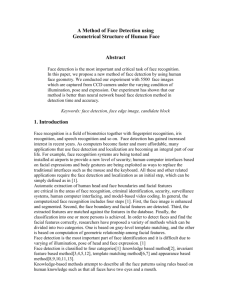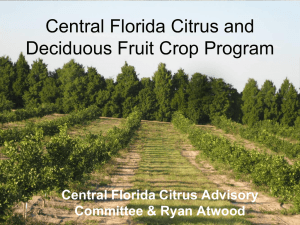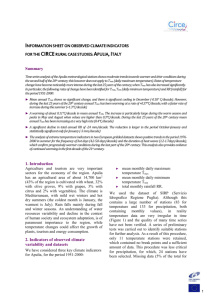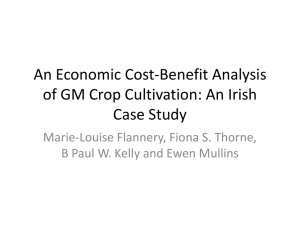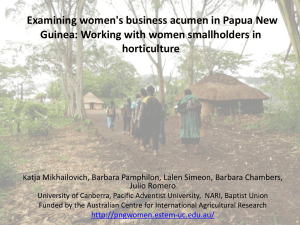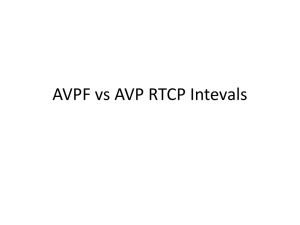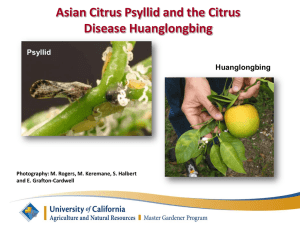presentation
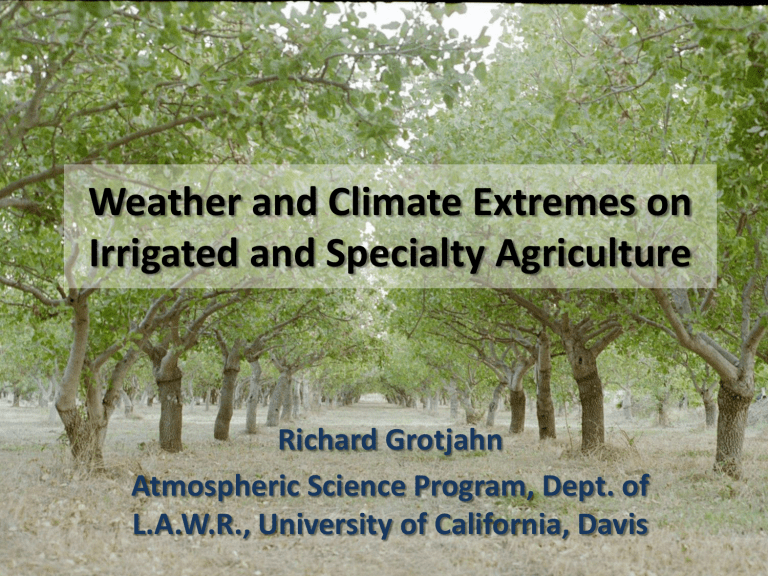
Weather and Climate Extremes on
Irrigated and Specialty Agriculture
Richard Grotjahn
Atmospheric Science Program, Dept. of
L.A.W.R., University of California, Davis
Acknowledgments
• Interviews/correspondence:
–
A. Bloom,
–
T. DeJong
–
J. Hill,
–
H. Lieth,
–
R. Snyder,
–
J. Wolpert
E. DePeters,
J. Hatfield,
K. Larson,
F. Mitloehner
J. Strand,
• Published Sources
–
As indicated
2 of 22
Outline
1. Overview of some general issues relating to ag
2. Extreme weather impacts in specific ag commodities
3. Example extreme events economic and other impacts
4. Summary overview of extreme weather factors.
3
• One of coldest CAOs (Cold
Air Outbreaks) on record for
SE US.
• >80% juicing oranges spoiled
• >50% the citrus trees killed.
• But monthly mean T was above normal! (+0.8 C;
+1.44F)
• Good News: Dec. 83 was a little above average.
• Bad News: 2 cold days (~15C below average) wiped out your crop & orchard!
Florida Citrus:
December 1983
• Conclusion: The monthly mean misses this important event!
Daily anomaly temperatures for Winter
Haven, Florida in heart of citrus growing region.
4
Some complicating matters
• Impact of weather factors varies
– Timing in growth cycle more important than actual value
• Other factors than climate important:
– Varieties differ
– Water quality
– Soil quality
• Plants are time integrators:
– Chilling hours
– Prior year events
– Pest pressure
– Early events have later impacts
Yield versus monthy mean max temperatures. Each dot is a different year. Each color is a different CA county.
5
Figure: Lobell & Field 2009, CEC-500-2009-039-F.pdf
Phenologic Quantities
• Developmental temperature thresholds
– Lower = T below which development stops. E.g. 65F in banana plant; 9.4C (49F) for citrus flower.
– Upper = T above which growth rate decreases (data lacking)
• Physiological time
– Amount of heat/chill needed to fully develop (e.g. chilling hrs,
GDH)
– A combination of T above a threshold and time spent above that. 2 deg above threshold for 2 hours same as 1 deg above for
4 hours.
• Chilling hours are cumulative hours…
– Below 45F
– Between 32F and 45F
– During 1 November through end of February.
– Needed for sufficient dormancy for adequate dormancy break
6
California Agriculture
• California:
– Produces 64% (=$13B) of the US production of tree fruits and nuts. (>95% each of almonds, walnuts, and pistachios)
– 1 st in many products, notably Dairy, Greenhouse/nursery,
Grapes, Almonds, Lettuce.
– 2 nd largest rice producer (after Arkansas), citrus (after FL)
– 8.7 M ac of irrigated farmland (8 M ac irrigated in 2007 due to drought)
• Major specialty tree crops include: almonds, stone fruits, (table) citrus, avocados. (~3 M ac of orchards)
• Major specialty non-tree crops include: strawberries, tomatoes, grapes, lettuce & cole crops.
7
Top 24
Calif.
Ag.
Commodities
Red is 1st in US
Yellow is 2 nd in US
California: Leading commodities for cash receipts, 2009
Rank Items indicates #1 state indicates #2 state
All commodities
Livestock and products
Crops
Value of receipts
1,000 dollars
Percent of total receipts
------------
34,840,647
7,814,006
27,026,641
100.0
22.4
77.6
Cumulative percent 1/
Percent
--
--
--
Percent of U.S.
value 2/
------------
12.3
6.5
16.5
1 Dairy products
2 Greenhouse/nursery
3 Grapes
4 Almonds
5 Lettuce
6 Strawberries
7 Cattle and calves
8 Tomatoes
9 Rice
10 Hay
11 Walnuts
12 Broccoli
13 Oranges
14 Pistachios
15 Carrots
16 Lemons
17 Celery
18 Peaches
19 Chicken eggs
20 Cotton
21 Raspberries
22 Cauliflower
23 Plums and prunes
24 Wheat
592,850
499,766
364,248
349,918
326,331
319,771
303,823
297,315
255,766
251,923
230,752
4,537,171
3,792,295
3,267,848
2,293,500
1,725,799
1,725,232
1,676,373
1,509,647
928,173
864,163
738,530
698,376
655,820
1.0
0.9
0.9
0.9
1.7
1.4
1.0
0.9
0.7
0.7
0.7
2.5
2.1
2.0
1.9
5.0
4.8
4.3
2.7
13.0
10.9
9.4
6.6
5.0
71.8
73.2
74.3
75.3
76.2
77.1
78.0
78.8
79.6
80.3
81.0
64.1
66.2
68.2
70.1
49.8
54.6
58.9
61.6
13.0
23.9
33.3
39.9
44.8
100.0
84.9
92.4
95.9
54.9
5.2
8.7
82.0
89.2
97.6
2.0
15.1
100.0
94.1
32.9
81.2
3.8
59.4
30.5
18.6
23.8
88.6
100.0
78.8
Value of U.S.
receipts
1,000 dollars
283,406,168
119,751,629
163,654,539
24,342,440
15,914,592
3,689,412
2,293,500
2,189,219
2,124,195
43,776,568
2,541,986
3,041,344
5,726,526
738,530
741,900
1,993,237
592,850
588,942
394,199
364,816
594,248
6,155,825
3,488,956
362,606
286,612
8 258,043
11,315,147
Some individual commodities
• (in
California)
Source: Lee etal 2009, CEC-500-2009-041-F.pdf
9
Commodity: Dairy
• Tmax, Ta-max
– T=20-22C optimal. Productivity declines ~2% for each 1C above
22C
– Heat stress is primary issue, so higher RH matters (heat index, apparent temperature, temperature-humidity THI>90 =>
20% drop in milk production)
– Heat stress causes cow to go off feed => no milk production. (2006 heat wave at least $95M milk production losses for weeks after)
– Locally might have 10% mortality during event (30,000 cows died
2006 HW; no night cool-down)
– Interrupted reproductive cycles…
Sources include: ag.arizona.edu/ans/swnmc/Proceedings/2008/13Bilby_08.pdf; dairy.ca.gov/pdf/annual/2006/cost_of_production_annual_2006.pdf; scientificamerican.com/article.cfm?id=got-goats-milk-the-quest;
Zibleman & Collier: Heat hits cows sooner than we thought
10
Commodity: Greenhouse/Nursery
• T max (T>90F foliage/yield loss, >100F deadly)
– Potted plants harder to keep root ball cool, root ball too small for foliage (excessive ET).
– Worse if combined with low humidity (30<RH<40% taxes plant; RH<20% severe)
– If windy: overhead evaporative cooling spray misses.
– Greenhouse cool only up to 20F below outside.
• T min (T<-2C)
– Outdoor stock may be freeze-sensitive (cosmetic issues matter) (2007 freeze: $161M losses)
– T>-2C workable; 25F<T<28F use overhead spray for LH release. If preceded by warm period, weak growth flush very sensitive. T<25F general crop loss.
• Other
– Timing messed up by extreme events.
– Structure damage. (2010 snow caused shade house collapses)
– Hail: structure breakage, plant trauma. (20110515 30% loss bedding plants in Sac.)
11
Sources include: weternfarmpress.com/…california-freeze-heat-disaster-funding
Commodity: Tree nuts
(esp. Almonds)
• Tmin (T<0C)
– Tree deciduous, extreme cold not usually an issue
– Warmer winter (less chill) leads to lower yields. Also true for walnuts.
– Warmer late spring leads to higher yields
– Frost at bloom kills pollen, nutset reduced
• Precipitation
– Plant naturally ‘drought tolerant’ but yields decline
(smaller nuts) with less water (drought) due to close spacing, etc.
– Rain at bloom inhibits nut set. (Feb for almonds, bees not flying, March/April for pistachios -- wind)
• Wind (>20m/s)
– Almond: Tree shallow-rooted, blow downs common if soil saturated.
– Pistachio: windfall not harvestable (not issue for
Almonds, Walnuts)
12
Commodity: Citrus
• Low temperatures: Temperature <0C & duration
– Ice formation in citrus tissues – Fruit damage occurs when the temperature falls below threshold for at least four hours. E.g. Oranges: T<28F; T<32 for true limes
– 3-4 hours @ 29F worse than half hour @ 25F
– Orange: 4 hours at 20°F kills 3/8 inch or smaller wood
– T< 28°F for 12 continuous hrs kills 2” limbs, possibly the entire tree.
– 2007 freeze: $800M losses. ($131M more to avocado)
– Warm wx prior worse: causes highly susceptible growth flush
• High T & low humidity
– Transpiration cannot keep up (hence drought stress) causing excessive fruit drop.
– sunscald
– Need T> 9.4C (49F)
• Developmental temperature
Sources include: M. Zekri, Fl. Coop. Ext
.
13
Commodity: Stone Fruits
• Tmin (too warm/ too cold)
– Insufficient chilling hours causes inadequate/irregular/extended/aborted bloom
– Freezing (T< -1C or -2C) including radiational, at bud break, flowering, & 7-10 days after fruit set.
• Tmax
– If Tmax<55F during bloom, bees don’t fly, no pollination
– Higher T during March-April lower yields/smaller fruit size in plum/peach/nectarine (tree cannot meet fruit demand). In Prunes: T>80F during bloom aborts pollination.
– Peaches/Nect. Tolerate high T up to 105F. But sunscald, later sutures.
– Cherries: 5% doubling T>104F for 3 hrs, 101-104F for 10hrs, 96-100F 37hrs.
– Overnight minimum too warm (Daily ave T>20-24 C causes >20% sutures) during very hot summer days causes following year problems: doubling in cherries; possible deep sutures in Peaches & nectarines if heat stressed.
• Precipitation
– During pollination period (bees not flying)
– After color develops in cherries (absorbs spits rots)
• Hail (especially early fruit stage nicks expand)
• Wind
– Poor blossom set for drying north winds (RH<40%)
Sources: fruitsandnuts.ucdavis.edu/datastore; http://homeorchard.ucdavis.edu/8007.pdf
http://www.goodfruit.com/Good-Fruit-Grower/March-15th-2007/The-causes-and-cures-of-doubling/
14
Commodity: Grapes
(Wine & Table)
• Freezes/late frosts (T<-2C; blossom, harvest)
– Poor/failed blossom set (dry winter => earlier budbreak) e.g. multiple late frosts in 2008. (Aside: Irrigation to mitigate drops water levels too low for fish)
– Worst if prior warm period (day+night average T>5-10C) pushes bud break.
– Cooler T delays bud break, development (pushes growing season into unfavorable late fall weeks) Need T>50F
• High Tmax (T>95F; >100F problematic)
– Depends on timing relative to mid-season thinning (July 2006 HW helped make up for delayed budbreak of cool spring)
– Late heat wave with low RH (Hot & dry, often with wind), can dry wine grape like raisin => too high sugar %, sunburn, shrink harvest pd. Example: Fall 2008
• Excessive precipitation
– In spring, disrupts regular deficit irrigation (too much plant growth)
– Disrupts raisin drying
– Rain during pollination inhibits fruitset. (=> 25% reduction in 1996)
15
Various sources, including: napavintners.com/about/ab_3_recaps.aspx
Commodity: field fruits
• Strawberries
– So. CA (late Nov. - early June);
– Coastal CA (March-Nov.)
– Frost/Freeze: (T<0C) Sensitive to freeze, especially during
& just after bloom. Mature fruit tolerates a few C colder.
($41M losses in 01/2007 CAO).
– Too warm (T>75F) Productivity drops. Ideal is 55-70F.
– Wind + Low RH (Santa Ana conditions) -> fruit dessicated
– Hail is rare but highly damaging
• Melons
– Tmin: Sensitive to freezing at any growth stage
– Tmax: Optimal 30-35C. Tolerates T=40C,
– Precip & Tmin: inhibition of bee pollination
RG image
Commodity: Tomatoes
• High temperature
– Plant suspends/aborts production, pollination fails for T>40C though plant survives. (Optimal daytime: 24C<T<34C).
– Sunscald (just prior to harvest in canning types)
• Low temperature
– Plant frost sensitive. Light frost: leaf defoliation.
– Need Tmin>55F for fruit set. Need T~20C for soil germination
(transplants now common, 30% in CA)
– Poor quality for Tmax<20C with Tmin<10C.
• Precipitation:
– Drought: plant needs much water (irrigation every 7-14 days)
– Heavy rain: causes skin splitting & rot (especially on hot fruit ), equipment can’t work field.
Sources: vric.ucdavis.edu
17
Commodity: Other field veges.
• Lettuce
– High Tmax – highly sensitive (early bolting for T>25C)
– Low Tmin/Tmax – slow development, disease issues at any stage of growth.
– Optimal is Tmax ~23C, Tmin ~7C.
• Leaf crops, Cole crops, other vegetables generally very sensitive to extremes during:
– Seedling establishment (hot or cold: spring or early fall)
– Frost or high heat at pollination (for crops sold as fruits)
• Optimal and max temperatures: (12-24C/ 24-35C)
– Optimal monthly max T: Cauliflower = 12C , Broccoli = 18C,
Celery = 18C, Carrots = 21C, Lettuce = 23C, Spinach = 24C
– Some growth for Tmax up to: Celery = 24C , Cauliflower = 27C,
Lettuce = 28C (if Tmin <12C), Carrots = 30C, Broccoli = 35C
Sources: vric.ucdavis.edu
18
Commodity: Rice
• Tmin (night temperatures)
– Too cool? Needs Tmin> 20C. T<55F and % blanks increases ( from 12 to 50%)
60-75d after planting (early in ‘heading’). (Also: cooler T slows maturation, pushes harvest into windier, cooler late autumn)
– Too warm? Grain-filling declines for 25C< nighttime T <33C; 10% decline for each 1C above 33C
• Tmax (T>100F a problem during pollen shedding)
• Temperature range: 50F <T<98F (no growth outside this range)
• Precipitation
– Spring precip. disrupts sowing (e.g. 2011)
• Wind (WS>20m/s)
– Lodging during harvest (after field water removal)
• Wind & RH (grain daytime dries then nighttime rehydrates)
– Wind accompanied by low RH (does not reach 90% at head height) grain shatters. (E.g. October 2004, WS>40 kph, gusts>70kph ; daytime RH 13%; 4 days of no hours >90% RH; head yields dropped 50%)
• RH (>50%: disease problems. Cracking if diurnal range too low at harvest.)
Sources include: arkansasagnews.uark.edu/571-39.pdf
postharvest.ucdavis.edu/datastorefiles/234-1290.pdf
19
Example Extremes & Their Effects
• Extreme heat
– 7/2006 Statewide. Long duration heat (record high Tmin) impacting dairy, cattle especially (~$1B in milk & cows).
Lesser impacts to field and orchard crops.
• Freezes/extreme cold air outbreaks
– 12/1998 Statewide $3.2B. Large citrus losses ( $90M lemons
& $500M oranges), avocadoes, broccoli, etc. Worst since record setting $5.5B 1990-1 event.
– 4/1999 San Joaquin. Late frost, ~-1C. Damaged vegetable starts, tree fruits at set, grapes.
– 1/2007 Statewide. $1.3B ag losses: citrus, avocado, nursery stock, strawberries.
• Heavy rain/flood leader in losses during 1993-2007.
– 3/1995 San Joaquin & S. Central counties. Heavy rains ( XX to
YYY cm in a day) caused flooding of fields halting work. Also had high winds damage. Flooding of field crops (lettuce, broccoli, cauliflower, strawberries) $4.1B losses
– 5/1998 San Joaquin. Heavy frontal system rains (accompanied by below normal T)
– 6/1998 S. San Joaquin. High runoff, caused flooding of 32k ac of farmland.
– 1/2005 S. Calif. Mudslides and flooding uprooting orchards.
– 1/2006, N. Calif. coastal counties. Saturated soils from prior frontal cyclones; heavy events followed: 10-15cm in a day and
3-8 cm 2 days later caused flooding of farmland.
Various sources, including Lobell etal 2009, CEC-500-2009-040-F.pdf; westernfarmpress.com
Blue: flooding, Orange: wind, Red: heat wave
20
Summary 1: Extreme weather effects
• Tmin (high or low) ranges vary with the commodity
– Some plants need T> Tmin (rice, cotton); some need nightly recovery T< Tmin.
– Freezing (or just below) often a key threshold: at blossom (tree crops), seedling (vegetables) & harvest (citrus)
• Tmax (unusually daytime high >95F) value varies with the commodity
– Exceed max developmental T,
– Duration of higher temperatures matter. (2 days in a row more severe than 1)
– If accompanied by low RH (<30%): dried wine grapes, shattered rice, stressed ornamentals)
• Tw, Td (high T & RH combination) value varies with the commodity
– Higher plant T stresses plants, especially if limits recovery and growth at night
– Exceed level of heat stress tolerated of lifestock
• High winds (>20 m/s)
– Blow down and dropping harvest on ground: pistachios, rice & other grains
– If accompanied by wet conditions, blow downs of shallow rooted trees (almonds)
• Excessive Precipitation
– Disrupts scheduled field operations (sowing, harvesting)
– Flooded field crops cause catastrophic loss, cosmetic & pest issues
– When temperatures high cause splitting/spoilage (tomatoes, cherries)
• Drought
– Perennials (strawberries, tree crops) more susceptible than annual field crops.
– Associated effects (higher summer Tmax, colder winter Tmin)
– Insufficient water for irrigation or frost protection
21
Summary 2: data needs
• Considered 10 commodities
• Needs and impacts vary but some generalizations are:
1.
Actual values matter, not trends or relative changes.
2.
Surface values matter, sometimes at high spatial resolution
3.
Timing of extreme event during production cycle is crucial.
Early stages: blossom, seedling, & fruit division, are when plant most vulnerable. Disrupting scheduled: actions, market.
4.
Duration of the extreme event important (covering whole pollination period, no nighttime recovery, etc.)
5.
Daily P, hourly T & RH likely best. Phenologic factors needed by growth models based on hourly data (GDH30, chilling hours) and differ between crops. Daily Tmax and Tmin is minimal.
6.
Accumulated factors (e.g. soil moisture) enhance or moderate impact of extreme event
22
Summary 3: data resolution
•
Near surface T (hourly) To assess chilling hours, phenology, etc. Alternative is approx. diurnal cycle from Tmin & Tmax (unusually high or low)
•
Near surface relative humidity (hourly) to match timing of temperature.
•
Precipitation
– Excessive (daily, if not 6 hourly )
– Drought (monthly, seasonal?)
•
Near surface winds (sustained, gusts; daily?)
•
Space resolution comparable to growing area
•
How to have sufficient accuracy near threshold?
• Thanks for your attention!
23

